A Perfect Combination of Craftsmanship and Design: An Interview with Leading Chinese Jewelry Designer Shirley Zhang
December 20, 2013
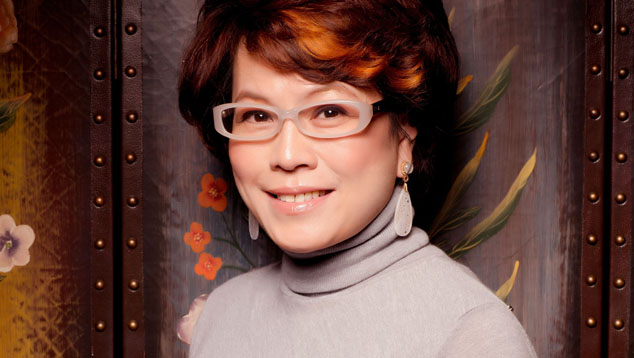
After receiving her FGA gemology degree in the early 1990s, Shirley stepped into the jewelry industry. Since then, she has steadily grown her own career as a jewelry designer. She is now one of the leading jewelry designers in China—one who is also recognized by professionals of the western world.
Shirley has created her special “z” style jewelry concept, which places emphasis on a combination of western craftsmanship and oriental aesthetic standards, and encompasses use of multiple materials and haute couture services. This concept has brought Shirley’s designs industry recognition as being representative of modern, elegant Chinese jewelry.
From retailer to designer
Between 1978 and 1990, the jewelry trade slowly grew out of the ruins left by China’s Cultural Revolution. The industry’s revival began after China re-opened the country to trade in 1978. Most merchandise on the market consisted of fine gold products, including some jewelry styles made with very simple craftsmanship. Consumer choices were very limited and they generally lacked knowledge about gemstones or jewelry.The next five years (about 1989 to 1995) witnessed a huge expansion of the industry. Many local jewelers opened businesses with big investments. Several Hong Kong and Taiwan jewelry companies sensed the potential of the mainland China market and started acting on that awareness. Consumers started paying more attention to jewelry styles and fashion trends, but their tastes were usually influenced by big promotional campaigns like those run by De Beers and others.
At that time, very few Chinese businesses understood the important role that branding played in merchandise promotion. Shirley opened a chain of retail jewelry stores in 1994. In 1996, she wrote her English name, “Shirley,” by hand, and used it as her brand. Within a short period of time, she had opened branded retail stores in 14 different cities in mainland China. Their success brought her more opportunities and access to the western world.
After 1995, the market became more regulated and consumers more mature. Shirley had started her retail stores right at the beginning of this period. Although business was good and profit was guaranteed, her merchandise had nothing—no “stories” of its own—to distinguish it from other brands.
Around 1999, Shirley was, for the first time, shocked by the big gap in jewelry design between the western world and the newly expanding Chinese market. During her first trip to Italy, she visited many jewelry stores and came to the realization that something was missing from her own brand in China. Instead of keeping the stores running, she made the very brave decision to shut them down.
She became a full-time buyer for Chinese jewelry import companies. This turned out to be a smart move and a turning point in her career. As a buyer, she had the opportunity to travel the world and meet experienced jewelry professionals. Her most important goal was to learn from their experiences and use that knowledge for her own career development.
Some of Shirley’s clients in Europe consider her jewelry taste to be very unique. Unlike many of her Chinese peers, she tended to purchase higher-quality goods that were also highly fashionable. This left very positive and pleasant impressions in her clients’ minds. Along with her unique tastes, Shirley is also a fast learner, pays a lot of attention to detail, and grasps every opportunity to learn from others.
Shirley’s design career really began with an education in craftsmanship. In Europe, she purchased jewelry pieces with elegant or complicated craftsmanship. Instead of wearing them, she took them apart and re-assembled them to analyze the manufacturing techniques used to make them. She also attended workshops and learned from master goldsmiths.
The experience Shirley gained from participating in the European market also triggered her consciousness of the oriental aesthetic. At the same time, the design concept of oriental artistic jewelry started to form and grow in her mind.
Taking the advice of an Italian friend, after seven years as a buyer she opened her own studio in 2004 and started to manufacture jewelry for some of her European clients. Although she designed some pieces here and there, most of the designs were still provided by her western colleagues. Gradually, her role started to shift. Eventually, she became both designer and manufacturer. Now she focuses solely on designing jewelry and developing new manufacturing techniques. She leaves most of the actual manufacturing work to the employees in her studio.
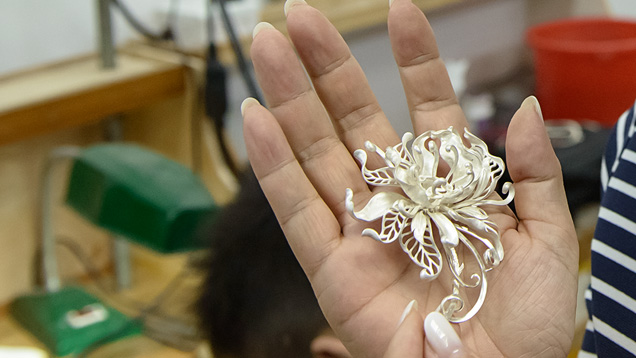
In the molding department of her jewelry manufacturing studio in Shenzhen, Shirley displays a silver mold of one of her designs. – Photo by Eric Welch, © GIA
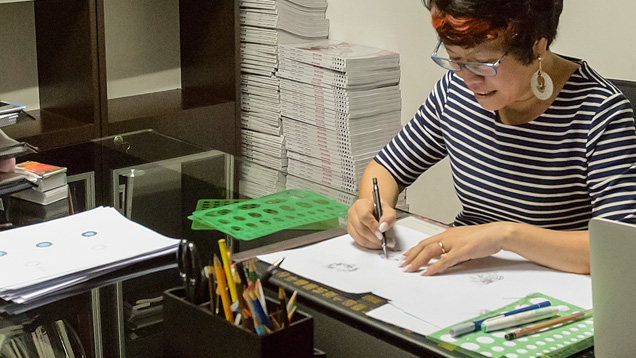
Shirley now spends more time on high-end jewelry design and leaves most of the manufacturing work to her employees. – Photo by Eric Welch, © GIA
A perfect combination of western craftsmanship and oriental aesthetic standards
Shirley’s design inspirations come mostly from her daily life. For example, her love of birds and flowers inspired her to design the series called “The Spirit of Peacock” and “The Love of Flowers.” In her work, she pays special attention to color and the arrangement of various objects in a design.As a newly assigned board member of the ICA (International Colored Gemstone Association), Shirley made a presentation about color’s influence on her jewelry designs at the 2013 ICA Congress in Changsha, China.
Color played a very important role in the development of China’s jewelry design industry. From the all-the-same green and gray uniforms people wore during the Cultural Revolution to the pale red and blue sapphire rings people preferred in the 1980s and 1990s, Chinese consumers have made a lot of progress, gradually adjusting to the fast-developing economy and changes in lifestyle. Life in this new century has been colorful to a level unprecedented in China’s history.
Sensing this change, Shirley uses colors boldly in her designs. In some designs, she emphasizes the fine colors of the gemstones themselves. In other pieces, she tries to demonstrate harmony by combining different colors. She also likes to match colors with different shapes or cultural themes. She loves to use colors but is not limited by them.
Besides color awareness, Shirley also has the unique ability to combine different materials. She often lays out a lot of different materials in her studio and tries different combinations of a variety of materials and jewelry parts and varied types of craftsmanship. For example, she tries to combine faceted stones and cabochons, metal and wood, china and crystal gems, enamel and gems, and more. Her creative combinations awaken the spirits of all these varied materials.
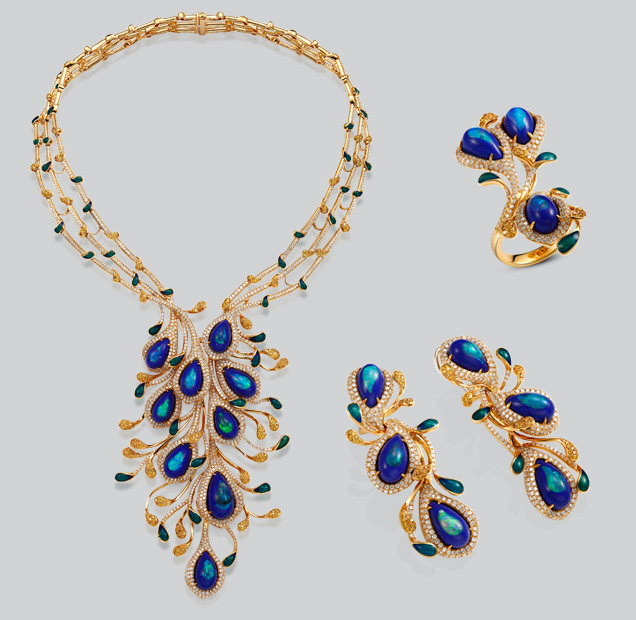
Shirley has designed many jewelry pieces with animal themes. She used a very unique inlay method to show the peacock’s colors in this jewelry set, which is called “The Spirit of Peacock.” – Photo courtesy Shenzhen Meiher Jewelry Ltd.
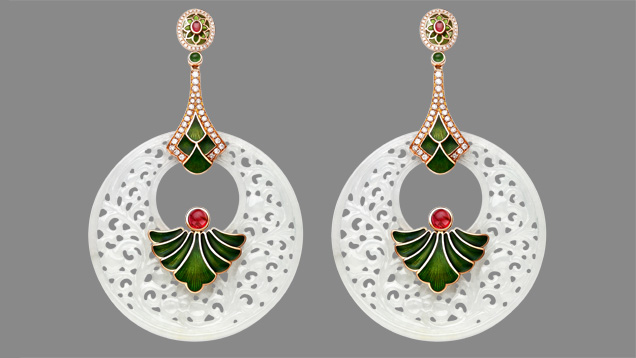
Shirley created this design to demonstrate harmony among different colors and shapes. She used carved jadeite to symbolize Chinese culture. – Photo courtesy Shenzhen Meiher Jewelry Ltd.
Unlike many other designers, Shirley was not an art major. She started her design career by learning craftsmanship from experts in the field. Aside from design concepts and ideas, whether or not a design can be turned into an actual jewelry piece is another serious consideration. Besides designing jewelry, Shirley has spent a huge amount of time researching and developing new craft skills and techniques. The combination of traditional lost-wax casting and die-striking in the creation of a single jewelry piece is one of her famed inventions.Over the past 10 years, she and her colleagues have gained numerous patents for jewelry manufacturing and stone-cutting techniques. Her research and exploration distinguished her from her competitors and gave her a leading position in China’s jewelry design industry. Shirley is very familiar with jewelry manufacturing techniques and the market’s current fashion trends. When faced with the question of how to make her “Shirley” brand stand out, she chose to combine western and oriental cultural elements in her own unique way.
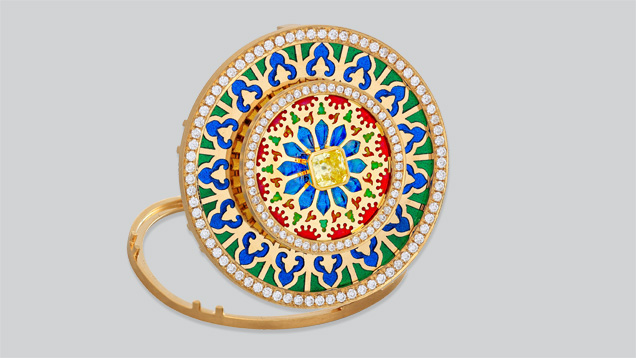
This is a see-through enamel finished product. Shirley Zhang’s factory is the only manufacturer of see-through enamel in China. – Photo courtesy Shenzhen Meiher Jewelry Ltd.
Consumers’ needs inspire and guide Shirley’s designs. She states that before she sketches a design for a consumer, she needs to have knowledge of new fashion trends as well as of the consumer’s personality and color preferences. If she is designing for a brand, she must know what the brand strategy is. She needs answers to all these questions before she starts working. In her eyes, whether a design is pretty or not is not as important as whether or not it matches the customer’s style. She wants her design to best represent the heart and inner being of her client.Artistic jewelry: new ideas for the rapidly developing Chinese jewelry market
Shirley’s more than 20 years’ experience as a jewelry professional parallel the biggest changes in the history of the Chinese jewelry industry. Shirley and her business experienced a lot of those changes along with the industry.Market changes are usually directly influenced by consumers. Twenty years ago, because Chinese consumers focused only on the material the jewelry was made of, most jewelry stores carried only fine gold jewelry. Besides the rich history of gold jewelry in China, value retention was the main reason for consumers to buy. Later, people slowly gained knowledge about gemstones like diamond, ruby, and sapphire. The promotions done by some international brands influenced Chinese consumers to start accepting jewelry pieces set with gems, even while they remained focused mainly on the value of the precious metal and stones.
At the time, all stone-set jewelry had a similar look, so the emphasis was on specific jewelry features. For example, a buyer looking for a piece of jewelry would insist that it be set with a 10-point diamond with a clarity grade of VVS or above and color grade of G or better.
About five years ago, Shirley noticed some sharp shifts in the market. Before that, her clients had been mostly from overseas. Today, she serves mainly domestic clients, both individuals and known brands. Her customers fall into four main categories: investors, collectors, accessory-driven clients, and those who value China’s cultural inheritance. Consumers no longer focus only on materials. Today, they pay more attention to jewelry designs. She admits that there are still big differences among various demographic groups. Older consumers still want better-quality materials that keep their value, while young people prefer fashionable and unique designs without much regard for the stones used.
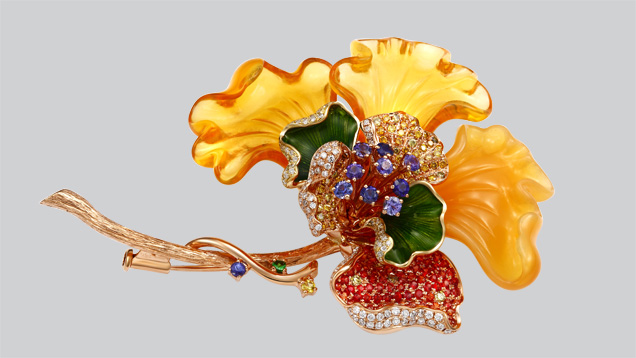
This is an example of the designs Shirley creates for her high-end customers. It’s a great combination of manufacturing skills, color, and shape. – Photo courtesy Shenzhen Meiher Jewelry Ltd.
Shirley shares the same views as other designers in terms of jewelry buyers’ motivations. She sees no big difference between international and domestic consumers. She does see that more and more young Chinese office workers are buying jewelry for themselves as rewards or gifts. This is similar to what happened in the US, when more women became independent and went off to work.To satisfy the mature western jewelry market as well as the newly developed Chinese market, Shirley and her team have designed many jewelry series that have been well accepted and appreciated by consumers. Some examples are “The Love of Flowers,” “Birds Chirping,” “Spirit of Jadeite,” and “Dancing on the Flowers” as well as some new-technique enamels. These products all provide a combination of western craftsmanship and oriental aesthetic standards that have become consumer favorites.
Shirley and her colleagues are very optimistic about the future of the Chinese jewelry market. Chinese consumers are fast learners as well as great inheritors of their ancestral culture. They are quickly educating themselves and becoming some of the most powerful buyers in the world. Shirley says that all designers should realize this and be ready to supply this market without being left behind.
Skilled craftsmanship and western and oriental aesthetic standards combined with haute couture services
Successful jewelry designers usually have their own art studios. Shirley’s business model is quite different from most of the others. Its uniqueness is apparent in the company name: Meiher Jewelry Styling Research Center.The GIA team visited Shirley’s company in June of 2013. The visit began with a factory tour. It was not a big factory. Shirley repeatedly emphasized that she tries to include every step, from design to finished product, in this small factory. She maintains full contact with all these steps so she can research and develop new techniques. The factory serves as both a production line and a lab.
She proudly informed us that Meiher is the only jewelry company in China that can make transparent enamel. Enamel is usually painted on some sort of base material. This new technique eliminates the base and lets the enamel stand alone, allowing people to see through it. Several technicians are working hard to develop this technique and they already have created some finished product.
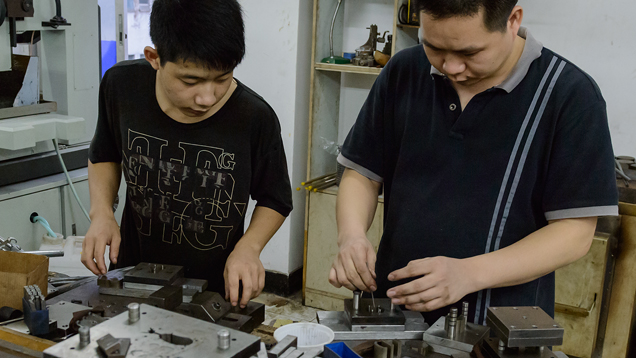
In Shirley’s factory, you can observe every jewelry-making step. The facility includes a die-striking department. – Photo by Eric Welch, © GIA
For the past ten years, Shirley has designed for many famous jewelry brands in China—both commercial quality and high-end. Today, she focuses mainly on the haute couture market. Her design studio in Beijing serves only celebrities and other high-end customers.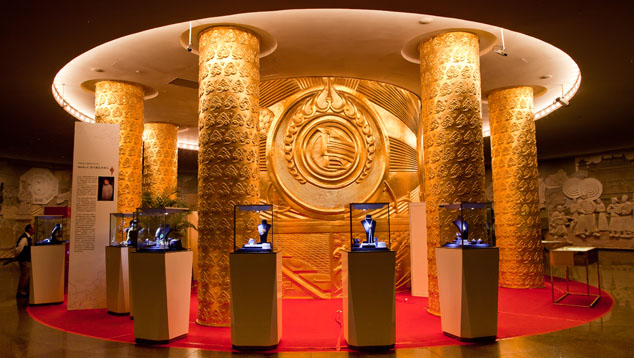
This exhibition, held for high-end clients, displays customized jewelry designs by Shirley Zhang. – Photo courtesy Shenzhen Meiher Jewelry Ltd.
A milestone in Shirley’s design career
When many people think about Shirley, the first design that comes to mind is her award-winning piece, “Dancing on the Flowers.” Inspired by the way bees interact and work together diligently, Shirley brought her passion for gemstones and manufacturing skills into designing this jewelry suite. The suite was given a special award as the gift for the “20 years’ accomplishments of the Chinese jewelry industry” at the 2012 NGTC (National Gems & Jewelry Technology Administrative Center) jewelry design and manufacturing skills competition.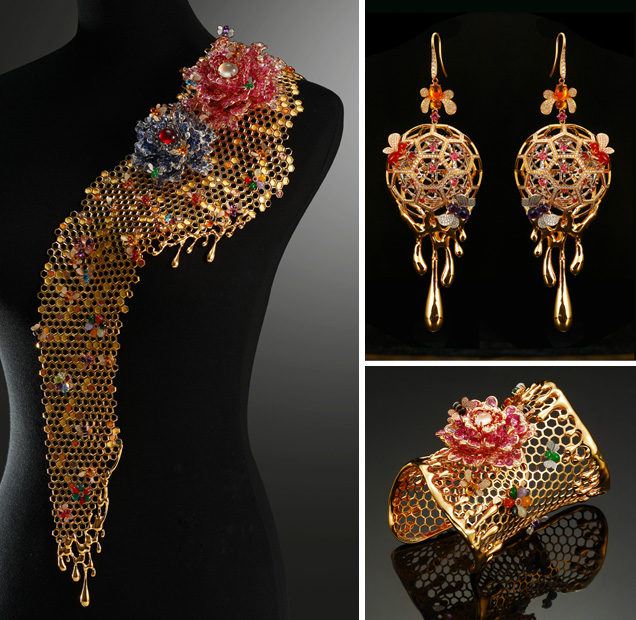
This is Shirley’s award-winning jewelry suite called “Dancing on the Flowers.” The suite was designed and manufactured by Shirley Zhang. – Photo courtesy Shenzhen Meiher Jewelry Ltd.
To emphasize the “accomplishments” aspect, along with the theme of the jewelry design competition, which was “impression,” Shirley chose to use different gemstone varieties and apply different mounting and cutting styles. The suite includes a cape, a cuff bracelet, and a pair of earrings. Colorful bees are busily working on the flowers and bringing honey back to their beehives, which consist of numerous cells. The design symbolizes the people in China’s jewelry industry who, like the bees, diligently contribute to the industry’s accomplishments and growth over the past 20 years.Of the three items, the cape is the most breathtaking. It is more than 1 meter (3 feet) long, and made by applying traditional lost-wax casting and die-striking. It features newly developed “dumbbell” buckle links and a patented “honeycomb” setting. The “dumbbell” buckle link effectively connects all the beehive cells and allows them to move freely together as well as individually. When it is worn, it drapes on the wearer’s shoulder and conforms to the body. The wearer feels the fabric-like softness created by the special link system.
Another advantage of this link system is that it is easily assembled or taken apart, which gives its wearer maximum wearing flexibility. The owner of this cape can actually create other jewelry pieces by disassembling it or assembling it in a different way.
Close attention to the flowers on the cape and the cuff bracelet reveals the special mounting, called a “honeycomb” setting. By applying this technique, both sides look the same because light is able to travel through the gemstones. Previously, it was difficult to mount stones in a floral design because larger stones don’t easily fit in and the backs of the flowers have a very unpleasant look because the light is blocked. The earrings are also delicate in their design. The honeycomb pattern allows people a 360-degree view of the earring. The inner and outer spheres can move individually.
This jewelry suite is set with 1,002 colored stones and 4,986 diamonds. It contains both extremely expensive, high-quality jadeite cabochons and very affordable chalcedony cabochons. Shirley also tried to use gemstones of different cuts and sizes. Shirley has many famous designs, but she says this is definitely her favorite, since it is a perfect combination of her design and delicate craftsmanship techniques.
Through the years, Shirley has devoted herself to the study of different gem materials and jewelry manufacturing techniques. She created and patented new jewelry-making methods and revived old ones. Her designs express her love of nature. Shirley and her colleagues have kept bringing surprises to the industry.
Suggestions and expectations for future designers
Before our formal interview, Shirley talked about her experience as a mentor and advisor of young jewelry designers and jewelry design students. As a NGTC professional instructor, she travels to different cities to give lectures on jewelry design and manufacturing. At the same time, she gets invitations from universities with jewelry design programs to lecture the students. Shirley came to notice that when she looked at the designs the students presented to her, she realized that many of them couldn’t be manufactured.The students were good at presenting innovative ideas, but did not know much about the craftsmanship side of the business. Many of their educational programs only teach the students how to design a piece of jewelry instead of how to design and then make it. Based on her personal experience, Shirley believes that it makes more sense to learn craftsmanship before design concepts.
In this information era, young people are surrounded and sometimes overwhelmed by all the information they can easily access. Shirley hopes that students can “stay down to earth.” She says that young designers can’t be successful without being good at both craftsmanship and design ideas.
About the Authors
Doctor Tao Hsu is the Technical Editor of Gems & Gemology. Andrew Lucas is Manager, Field Gemology, for Content Strategy at GIA Carlsbad.
Acknowledgments
The authors gratefully acknowledge the assistance provided by Shirley Zhang and Yuxi Zhang during our stay in Hong Kong and Shen Zhen. We would also like to thank the staff of workers in Shirley’s factory for staying late to guide us during our visit.
.jpg)


